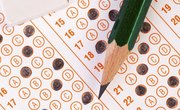Assessment of learning and achievement begins for students at a very young age. The Stanford Early School Achievement Test, or SESAT, is administered to children in kindergarten and the first grade, at the midpoint during each school year, to gauge their skills in basic arithmetic, reading and comprehension.
The SESAT is part of the Stanford Achievement Test Series, which includes 13 test levels and is available in multiple configurations based on grade level and subject matter, including mathematics, language, spelling, environment, science, social science and listening. The test series has been touted by its publisher, Pearson Education, Inc., as “the standard for national norm-related testing for over 80 years.”
Importance

The children who take the SESAT are five or six years old, and this assessment can have a big impact on how their early academic careers unfold. The SESAT has gained in popularity as an adjunct to the regimens established to satisfy the standardized testing requirements of the No Child Left Behind Act of 2001. Although testing is not mandatory until the third grade, the SESAT scores can provide an early indication of a student’s abilities or special challenges, and they become a baseline for comparison to future assessments.
Description
The SESAT is divided into sections. Most of the questions on the test are multiple choice and have three possible responses. Students are asked to read words and to demonstrate comprehension of short stories, to show basic numerical reasoning and an ability to do simple arithmetic. Administration of the full test requires 10 sessions, ranging in length from 25 to 45 minutes. The test results include local and national rankings and are expressed as percentiles and “scaled scores,” rather than as numerical totals or letter grades.
Controversy

The value of testing children at such a young age is not fully established, and some educators believe it might even be harmful. Currently more than 25 states require assessment of kindergarten children, a practice that has proliferated in recent years because of federal incentives. Supporters of testing maintain that it is an important tool that provides an objective and reliable way of evaluating students’ abilities. Opponents point to research indicating that standardized tests, particularly among younger children, are neither a reliable measure of children’s knowledge nor a valid predictor of future success in school. The Association for Childhood Education International, in a recently published report, argued that standardized testing leads to negative labeling of young children and causes teachers to spend too much time “teaching to the test.” The report states that “high-stakes testing not only negatively affects motivation and learning, it also undermines the curriculum.”
Related Articles
References
Writer Bio
Todd Sallo has been a professional writer and editor since 1991. His areas of expertise include K-12 and higher education policy, science and health-related topics, language and fine arts. Sallo’s articles have appeared in “National CrossTalk” magazine and in the 2012 book, “American Higher Education.” He holds a Bachelor of Arts in history from the University of California, Santa Cruz.











